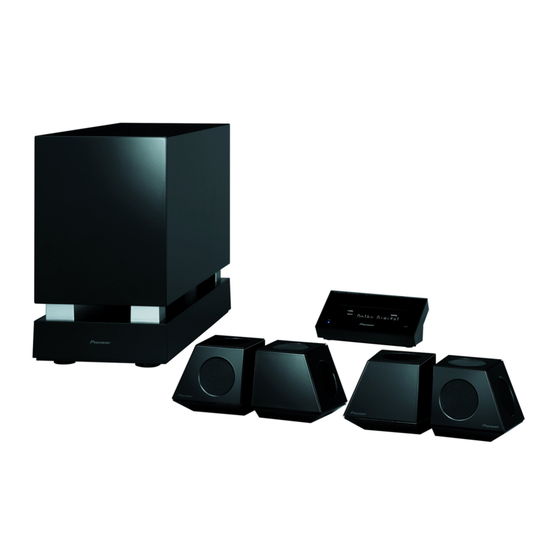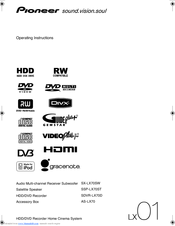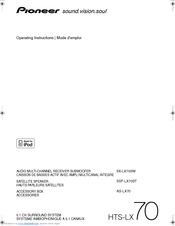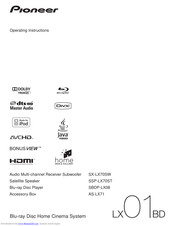
Pioneer SX-LX70SW Manuals
Manuals and User Guides for Pioneer SX-LX70SW. We have 6 Pioneer SX-LX70SW manuals available for free PDF download: Operating Instructions Manual, Service Manual
Pioneer SX-LX70SW Operating Instructions Manual (182 pages)
HDD/DVD Recorder Home Cinema System
Brand: Pioneer
|
Category: Home Theater System
|
Size: 13.04 MB
Table of Contents
-
-
Section Two
55-
6 Recording
91 -
7 Playback
103-
Introduction103
-
Basic Playback103
-
Scanning Discs108
-
-
Repeat Play110
-
-
-
9 Editing
117 -
-
Introduction127
-
One Touch Copy127
-
Using Copy Lists128
-
Recording Mode131
-
-
-
The Photoviewer
140-
Printing Files146
-
-
Basic Settings147
-
Optimize HDD148
-
Initialize HDD148
-
-
-
Troubleshooting165
-
Handling Discs174
-
Condensation174
Advertisement
Pioneer SX-LX70SW Operating Instructions Manual (179 pages)
HDD/DVD Recorder Home Cinema System
Brand: Pioneer
|
Category: Home Theater System
|
Size: 6.94 MB
Table of Contents
-
-
-
Display Unit14
-
Display15
-
-
-
Display16
-
-
-
-
HDMI Control
44 -
-
Section Two
54
-
Section Two
55-
6 Recording
91-
Basic Playback103
-
Introduction103
-
7 Playback
103-
Scanning Discs108
-
-
Search Mode109
-
-
9 Editing
117 -
-
Introduction127
-
One Touch Copy127
-
Using Copy Lists128
-
Recording Mode131
-
-
-
The Photoviewer
140-
Printing Files146
-
Basic Settings147
-
-
Troubleshooting165
-
Condensation174
-
Handling Discs174
Pioneer SX-LX70SW Operating Instructions Manual (114 pages)
5.1 CH SURROUND SYSTEM
Brand: Pioneer
|
Category: Home Theater System
|
Size: 4.1 MB
Table of Contents
-
English
6-
-
-
-
Side Panel10
-
Rear Panel11
-
-
-
-
Display Unit16
-
Display17
-
-
-
-
-
-
About HDMI45
-
-
-
-
General52
-
Tuner53
-
Hdmi53
-
XM Radio55
-
SIRIUS Radio55
-
-
Français
62-
-
2 Connexions
66 -
-
Télécommande74
-
Sirius76
-
-
-
-
-
À du HDMI101
-
9 HDMI Control
102 -
-
-
Syntoniseur109
-
Hdmi109
-
Radio XM111
-
Radio SIRIUS111
Advertisement
Pioneer SX-LX70SW Operating Instructions Manual (116 pages)
Blu-ray Disc Home Cinema System
Brand: Pioneer
|
Category: Home Theater System
|
Size: 8.4 MB
Table of Contents
-
-
-
-
-
Rear Panel10
-
Side Panel10
-
-
Display Unit11
-
-
-
Display Unit16
-
Display16
-
-
-
Display17
-
-
-
-
-
Ipod Cable42
-
-
Section Two
56
-
-
3 Playback
67 -
-
-
-
-
Specifications101
-
Cautions on Use102
-
Glossary103
-
Aspect Ratio103
-
Audio Language103
-
Cleaning Discs103
-
Storing Discs103
-
Dynamic Range104
-
Parental Lock104
-
Progressive Scan104
-
Secondary Audio105
-
-
Licenses106
Pioneer SX-LX70SW Service Manual (141 pages)
AUDIO MULTI-CHANNEL RECEIVER SUBWOOFER
Table of Contents
-
-
5 Diagnosis
20 -
-
Test Mode52
-
-
-
-
Display Unit74
-
-
-
Hdmi Assy (2/2)100
-
Ainb Assy102
Pioneer SX-LX70SW Service Manual (141 pages)
AUDIO MULTI-CHANNEL RECEIVER SUBWOOFER
Table of Contents
-
Jigs List14
-
Cleaning14
-
Diagnosis20
-
Error List48
-
Service Mode52
-
Test Mode52
-
Disassembly57
-
Adjustment62
-
Display Unit74
-
Hdmi Assy (2/2)100
-
Ainb Assy102
Advertisement





